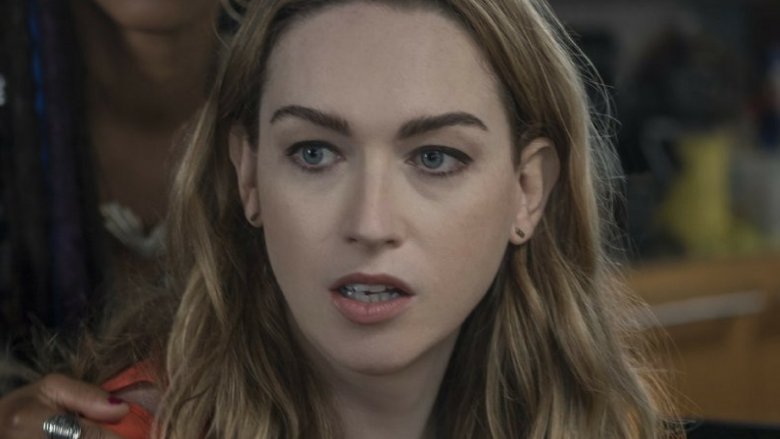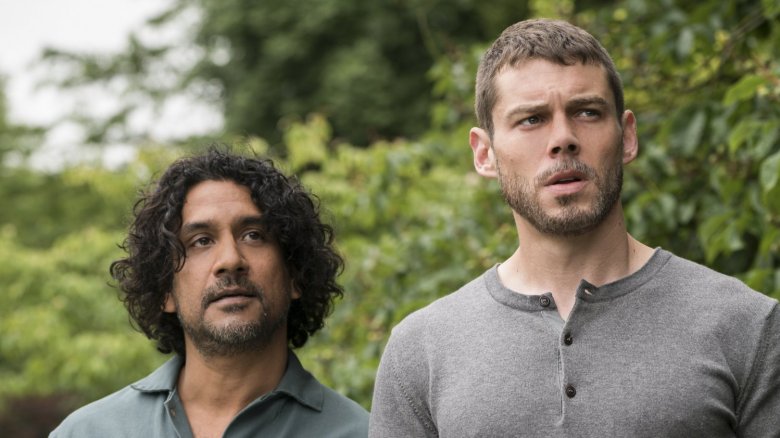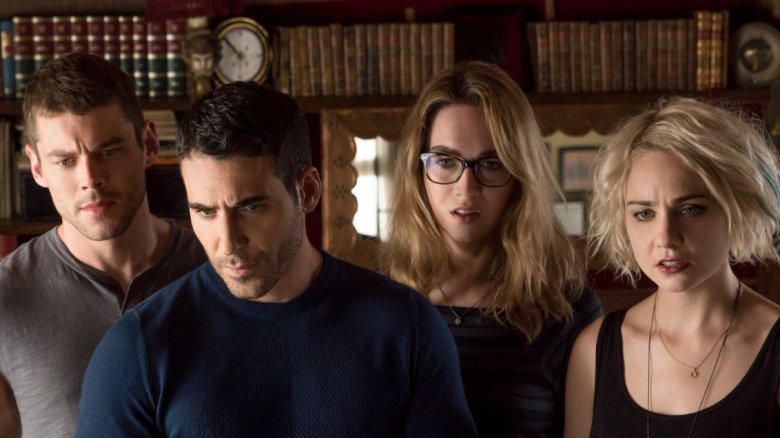The Real Reason Sense8 Was Canceled
Netflix's cancelation of the ambitious, inclusive Sense8 was a blow heard across the world. The move is strange for Netflix, which isn't known for canceling many shows, and came just weeks after the release of a well-received, long-awaited second season. Fans immediately started a social media campaign for the show to get a third season, resulting in a petition that has already garnered hundreds of thousands of signatures.
While Sense8's cancelation certainly comes as a surprise to fans of the show, there were actually quite a few signs pointing to the idea that the series wouldn't live to see another season. Here are the real reasons Sense8 was canceled.
It had a big price tag
Netflix is very, very secretive about what goes into their content-making decisions, but their recent cancelation of Sense8, along with one-season wonder The Get Down, offer a bit of an insight into what the streamer is looking for. While Netflix has for a long time given off the impression that money means nothing to them, with a massive $6 billion content budget funding huge film acquisitions and big TV shows, their two recent cancelations show they aren't entirely immune to budgetary concerns, as both were among the most expensive shows on television.
Sense8 filmed all over the world, and the cost of flying to and filming in real locations just kept adding up, especially with the series' expansive cast. Reports put the show at $9 million per episode, which is on par with the later seasons of HBO's juggernaut Game of Thrones. As Sense8 star Brian J. Smith acknowledged when posting on Twitter asking fans to push for the show's renewal, that price tag requires quite a few eyeballs to justify, and, although Netflix doesn't release ratings, there are other signs pointing to the fact that Sense8 just wasn't reaching that many people.
It spent a long time in production
Sense8's international production is also an organizational nightmare, which means production takes a long, long time. This explains the two-year delay between the first and second seasons, with the show filming at over a dozen places on four continents. In addition to driving up the cost of hiring crew members, this long production, coupled with pre-production and post-production, meant that Netflix had to shell out a lot of cash to keep the big cast on contract.
They decided not to do this after the completion of season two, letting the casts' options expire to save up on expensive talent-holding fees. This meant ordering a third season would have required renegotiating new contracts with the entire of the cast, an added headache on top of an already difficult production. Letting the casts' options expire also meant that actors had the chance to sign on to other projects, and, while none of the eight main cast members did, supporting cast member Naveen Andrews joined the CBS pilot Instinct, meaning he only would have been available for guest starring roles on a potential third season.
Although Netflix did reportedly start looking into renewing the casts' contracts for a third season, the amount of time in pre-production, production, and post-production just made Sense8 harder to produce operationally and continued to drive up costs, making it more tempting to take the series off the air.
It was very hard to market
Marketing is key, and a lot of it comes down to being able to boil a show down to a tagline or a 30-second teaser. Even though these short glimpses aren't enough to sell what they're truly about, they're enough to pull audiences in For Sense8, though, the show's complicated premise made it pretty much impossible to reduce to an easily digestible piece of advertising. Sense8 was a twisty, deep, and engaging journey from start to finish, but it could also, at times, be a very, very confusing path to follow, making it hard for Netflix to explain to potential viewers or even friends to sell the show to each other through word of mouth. While for many fans this was part of the series' draw, it was also a big turnoff for others, and just another obstacle in finding a way to draw in viewers.
Reviews weren't always great
Netflix shows are generally well reviewed. Sense8, though, earned the ire of some critics when it premiered, with many accusing it of wasting its premise and being, as Entertainment Weekly's Melissa Maerz put it, "the very essence of Too Much." While critics praised the series' diverse cast and its gorgeous visuals, many just had too much difficulty figuring out what was going on to give the show a positive review, resulting in the series debuting with a 67 percent on Rotten Tomatoes.
While this is definitely a respectable rating, it comes nowhere close to the first seasons of other Netflix originals. Orange is the New Black earned 93 percent for its first season; House of Cards earned 86 percent; 13 Reasons Why also earned 86 percent. The critical confusion surrounding the series might have turned off some potential fans, leading to lower viewership numbers and less social media buzz than Netflix was hoping for.
It improved over its run, but many viewers had already stopped watching
Sense8 improved over its run with critics and with fans. The first season had an increasingly dramatic trajectory, and by the end, many fans were hooked; the second built even further on this, earning far better marks from reviewers and falling at a much more respectable 86 percent on Rotten Tomatoes. However, the problem with a show that builds to better quality is that it's always going to be hurt by the short attention spans of viewers who stopped watching after the first 10 minutes.
Sense8 didn't have the same immediate hook as other well-received series, which meant it had already lost a lot of viewers before it found its stride. Although the show's quality continued to improve throughout seasons one and two, it wasn't enough to re-hook lost viewers.
A lack of major award nominations
Netflix has had a long history of award-friendly shows, with its originals racking up Emmy and Golden Globe nominations left and right. (Orange is the New Black currently holds six Golden Globe nominations, 13 Emmy nominations, and four Emmy wins; House of Cards has two Golden Globe wins, six Golden Globe nominations, six Emmy wins, and 39 additional Emmy nominations.) Sense8, meanwhile, earned one Emmy nomination for Outstanding Main Title Theme but failed to garner any other major award nods. Its biggest win came for a GLAAD Media Award for Outstanding Drama Series in 2016, a huge accomplishment and representative of the show's mission of promoting diversity and inclusion, but not necessarily enough to give the show the name recognition and easy advertising that comes with Emmy and Golden Globe noms. Awards shows are a great way to get the name of a lesser-watched show out there to try and gather new viewers—this is another area where Sense8 failed to expand its audience.
Netflix is looking to cancel more shows
Sense8's cancelation could be part of a growing trend that sees more Netflix shows getting the axe. CEO Reed Hastings revealed in a recent interview that he believes that the streamer should actually be canceling more shows and making riskier content. According to Hastings, Netflix has had far too many hits recently, which means that they aren't taking enough chances. He cited recent hit 13 Reasons Why as an example of a risk that paid off, saying that the show "surprised" the company. "You get some winners that are just unbelievable winners," he said. "It's a great show, but we didn't realize just how it would catch on."
Hastings wouldn't reveal just what goes into Netflix's decision to cancel or keep a series, but he did say it's a combination of viewership and subscriber growth, noting that "mostly, it's how many people watch." Although Sense8 definitely fits with Hastings' calls for riskier content, if it really does come down to how many people watch, the series wasn't drawing in enough people to make it past Netflix's new, tougher standards.
Netflix has ambitious series in the pipeline
Netflix isn't wanting for upcoming content—the network has a whole host of new series planned, many of them hugely ambitious and, most likely, expensive. The streamer also continues to make huge film acquisitions as they push to expand and take over the movie business, just as they have with TV. Despite the huge amount of money Netflix has put aside for original content, high-budget projects do begin to add up, especially with the number of high-profile TV shows and movies that the streamer has in the pipeline. With Sense8's high costs and the fact that it wasn't as huge a hit as some of their past series, it makes sense that the streamer would want to cancel the series to free up money for a potential future hit.
Diverse TV shows may be more likely to get the axe
Sense8 was one of the most inclusive and diverse shows on television, delivering a message of love and acceptance that we all need to hear right now. This makes the cancelation hit even harder for the show's fans—but was it actually part of the reason why the show isn't living to see another season?
Hollywood has made strides towards diversity in recent years, but it's still far from perfect. The 2017-18 season delivered some pretty awful stats for women and people of color on TV, with only 20 percent of leads in this fall's broadcast series being Hispanic or non-white and only 35 percent female. Things were just as bad behind the scenes, with only 10 percent of showrunners being Hispanic or non-white and only 29 percent female. Sense8 had a huge amount of diversity both behind the camera and onscreen; co-creators Lana and Lilly Wachowski are both transgender women, and the show featured a transgender lead in Jamie Clayton. The show's international setting also meant a very diverse cast and exposure to cultures not usually shown on television. While this earned the show the love of a lot of fans, it also could have put it in danger.
As Variety's Maureen Ryan points out, while the introduction of new streaming services and the increase in scripted series may make it easier for female and non-white showrunners and talent to get in the door, those shows also appear to be some of the first to get the axe— like Netflix's The Get Down, which featured a hugely diverse cast, or WGN America's Underground, which told the story of people escaping from slavery before the Civil War. This could be a result of the entertainment industry being nervous to move away from what's worked in the past. While there are many other reasons behind Sense8's cancelation, seeing diverse shows get a quick axe is worrisome, and should definitely be a concern for fans and networks going forward.









